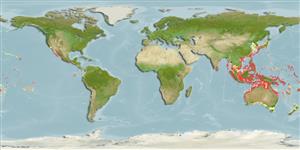Environment: milieu / climate zone / depth range / distribution range
Ecologia
marino associati a barriera corallina; distribuzione batimetrica 1 - 50 m (Ref. 9407). Tropical
Indo-West Pacific: Indonesia (including Mentawai Islands), New Guinea, and Philippines.
Size / Peso / Age
Maturity: Lm ? range ? - ? cm
Max length : 40.0 cm TL maschio/sesso non determinato; (Ref. 9407)
Spine dorsali (totale): 5; Raggi dorsali molli (totale): 31-34; Spine anali 3; Raggi anali molli: 24 - 28. Juveniles have extremely elongate vertical fins and closely resemble juvenile P. teira, but tend to be lighter with a silvery hue. Adults have smoothly rounded head profile like P. orbicularis, but usually have golden hue and lack small black spots (Ref. 37816). Adults (above 18 cm) yellowish silvery, usually with small, scattered black spots on body, dark bar through eye, and another bar just behind head. Median fins yellowish green. Anal-fin margin and rear margin of caudal fin black. Pelvic fins black. Small juveniles yellowish brown or silvery, with 2 black bars as in adults. Rear third of body blackish, the black colour continued onto dorsal and anal fins, and the front of the black zone on body often closely precede by a narrow faint dark bar. Caudal fin transparent except for black base. Jaws with bands of slender, flattened, tricuspid teeth, the middle cusp barely longer than lateral cups (Ref 43039).
Adults occur mostly in large schools along drop-offs, including outer reefs; singly in coastal waters. Juveniles are on deep slopes among tall coral formation (Ref. 48637). Benthopelagic (Ref. 58302).
Life cycle and mating behavior
Maturità | Riproduzione | Deposizione | Uova | Fecundity | Larve
Kuiter, R.H. and H. Debelius, 1994. Southeast Asia tropical fish guide. IKAN-Unterwasserarchiv, Frankfurt, Germany. 321 p. (Ref. 9407)
IUCN Red List Status (Ref. 130435)
Threat to humans
Harmless
Human uses
Informazioni ulteriori
Nomi ComuniSinonimiMetabolismoPredatoriEcotossicologiaRiproduzioneMaturitàDeposizioneSpawning aggregationFecundityUovaEgg development
BibliografiaAcquacolturaProfilo di acquacolturaVarietàGeneticaElectrophoresesEreditarietàMalattieElaborazioneNutrientsMass conversion
CollaboratoriImmaginiStamps, Coins Misc.SuoniCiguateraVelocitàModalità di nuotoArea branchialeOtolithsCervelliVista
Strumenti
Special reports
Download XML
Fonti Internet
Estimates based on models
Preferred temperature (Ref.
123201): 21.3 - 29, mean 28.2 °C (based on 798 cells).
Phylogenetic diversity index (Ref.
82804): PD
50 = 0.5313 [Uniqueness, from 0.5 = low to 2.0 = high].
Bayesian length-weight: a=0.02692 (0.01137 - 0.06373), b=2.94 (2.74 - 3.14), in cm total length, based on LWR estimates for this (Sub)family-body shape (Ref.
93245).
Trophic level (Ref.
69278): 3.5 ±0.3 se; based on size and trophs of closest relatives
Resilienza (Ref.
120179): Medio, tempo minimo di raddoppiamento della popolazione 1.4 - 4.4 anni (Preliminary K or Fecundity.).
Fishing Vulnerability (Ref.
59153): Low to moderate vulnerability (30 of 100).
Nutrients (Ref.
124155): Calcium = 41.7 [20.2, 78.7] mg/100g; Iron = 0.501 [0.278, 0.833] mg/100g; Protein = 19.2 [18.0, 20.3] %; Omega3 = 0.121 [0.073, 0.199] g/100g; Selenium = 31.3 [17.2, 61.8] μg/100g; VitaminA = 63.9 [18.2, 217.7] μg/100g; Zinc = 0.809 [0.542, 1.193] mg/100g (wet weight);
